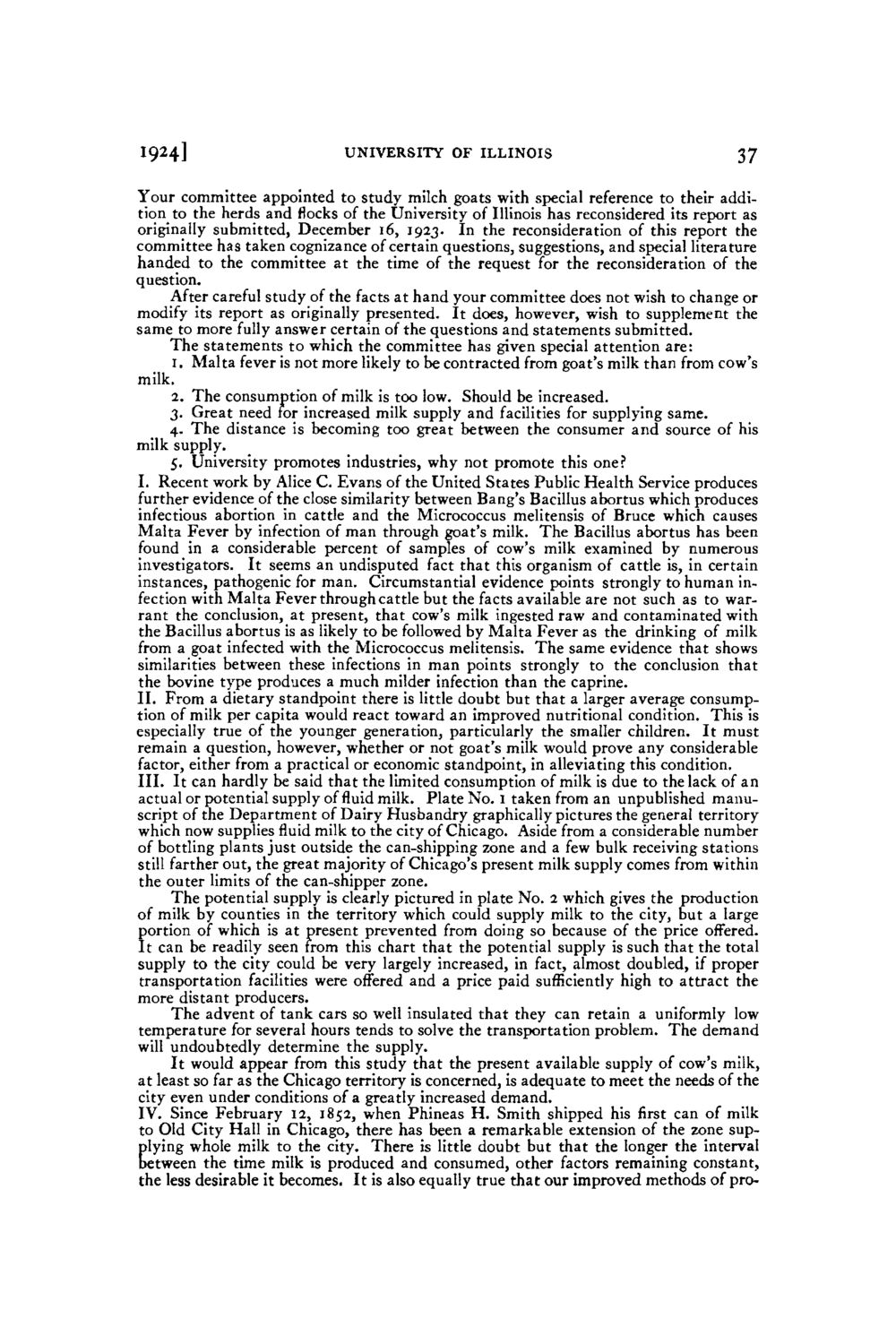| |
| |
Caption: Board of Trustees Minutes - 1926
This is a reduced-resolution page image for fast online browsing.

EXTRACTED TEXT FROM PAGE:
1924] U N I V E R S I T Y O F ILLINOIS 37 Your committee appointed to study milch goats with special reference to their addition to the herds andflocksof the University of Illinois has reconsidered its report as originally submitted, December 16, 1923. In the reconsideration of this report the committee has taken cognizance of certain questions, suggestions, and special literature handed to the committee at the time of the request for the reconsideration of the question. After careful study of the facts at hand your committee does not wish to change or modify its report as originally presented. It does, however, wish to supplement the same to more fully answer certain of the questions and statements submitted. The statements to which the committee has given special attention are: I. Malta fever is not more likely to be contracted from goat's milk than from cow's milk. 2. The consumption of milk is too low. Should be increased. 3. Great need for increased milk supply and facilities for supplying same. 4. The distance is becoming too great between the consumer and source of his milk supply. 5. University promotes industries, w h y not promote this one? I. Recent work by Alice C. Evans of the United States Public Health Service produces further evidence of the close similarity between Bang's Bacillus abortus which produces infectious abortion in cattle and the Micrococcus melitensis of Bruce which causes Malta Fever by infection of m a n through goat's milk. T h e Bacillus abortus has been found in a considerable percent of samples of cow's milk examined by numerous investigators. It seems an undisputed fact that this organism of cattle is, in certain instances, pathogenic for man. Circumstantial evidence points strongly to h u m a n infection with Malta Fever through cattle but the facts available are not such as to warrant the conclusion, at present, that cow's milk ingested raw and contaminated with the Bacillus abortus is as likely to be followed by Malta Fever as the drinking of milk from a goat infected with the Micrococcus melitensis. T h e same evidence that shows similarities between these infections in m a n points strongly to the conclusion that the bovine type produces a m u c h milder infection than the caprine. II. From a dietary standpoint there is little doubt but that a larger average consumption of milk per capita would react toward an improved nutritional condition. This is especially true of the younger generation, particularly the smaller children. It must remain a question, however, whether or not goat's milk would prove any considerable factor, either from a practical or economic standpoint, in alleviating this condition. III. It can hardly be said that the limited consumption of milk is due to the lack of an actual or potential supply offluidmilk. Plate N o . 1 taken from an unpublished manuscript of the Department of Dairy Husbandry graphically pictures the general territory which now suppliesfluidmilk to the city of Chicago. Aside from a considerable number of bottling plants just outside the can-shipping zone and a few bulk receiving stations still farther out, the great majority of Chicago's present milk supply comes from within the outer limits of the can-shipper zone. The potential supply is clearly pictured in plate N o . 2 which gives the production of milk by counties in the territory which could supply milk to the city, but a large portion of which is at present prevented from doing so because of the price offered. It can be readily seen from this chart that the potential supply is such that the total supply to the city could be very largely increased, in fact, almost doubled, if proper transportation facilities were offered and a price paid sufficiently high to attract the more distant producers. The advent of tank cars so well insulated that they can retain a uniformly low temperature for several hours tends to solve the transportation problem. The demand will undoubtedly determine the supply. It would appear from this study that the present available supply of cow's milk, at least so far as the Chicago territory is concerned, is adequate to meet the needs of the city even under conditions of a greatly increased demand. between the milk Chicago, is and littleH remarkablefactors longer can of milk plying desirable milk is city. whenhas consumed, butshipped hisfirstthe interval to Old City time in becomes. ItThere isequally.trueother that theremaining zone supIV. lesswholeHall itto12, 1852,there also been a doubt that our improved methods of prothe Since February the produced Phineas Smith extension of the constant,
| |